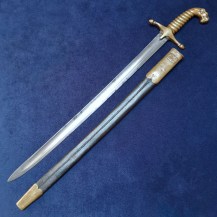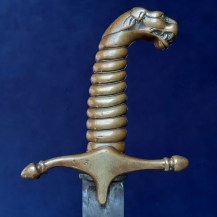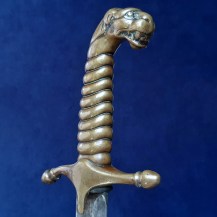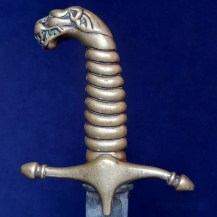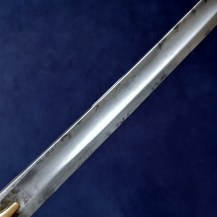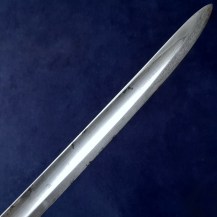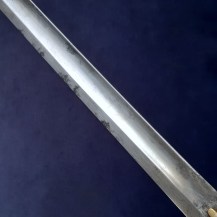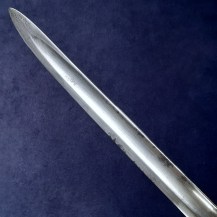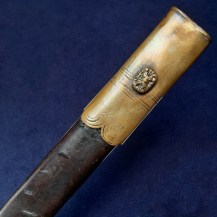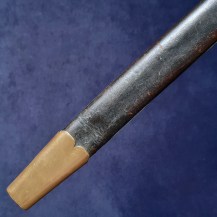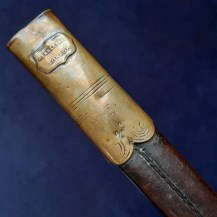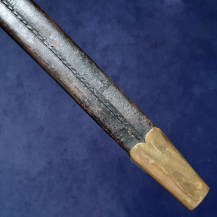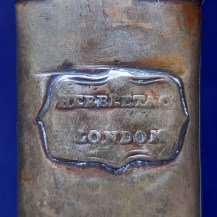British Circa 1820 Bandsman’s Sword, Shortened Transition Model, Scabbard by Hebbert & Co
Cast brass hilt and grip, the hilt of mameluke form with langets and conical finials, spiral grip, lion head pommel, black leather washer. Black leather scabbard with brass throat and chape pieces, the throat piece with frog stud. Blade 20 inches in length, the sword 24½ inches overall.
The throat piece of the scabbard is set with the maker’s mark ‘Hebbert & Co London’ and below this a rubbed mark including a ‘7’. The hilt is stamped with the number ‘3’.
Hebbert & Co was established in 1814 as Hebbert & Hume. It was primarily a helmet and accoutrement maker, but did retail some swords, the blades probably made elsewhere. After a period of sole ownership by Charles Hebbert it became ‘Hebbert & Co’ in 1850. This sets an earliest date for the top mount of the scabbard, although I think the sword may be older (see below). The firm occupied several premises in London over the years, until it closed down around 1912.
There was no standard pattern for the ornamental swords carried by military bands in the 18th and early 19th centuries. Each regiment was responsible for equipping its band as it saw fit, and took pride in outdoing each other in their parade dress. Nonetheless there was a common style: a short, usually curved mameluke-style sword with brass fittings and a pommel in the form of an animal head, most often a lion.
In 1856 all bandsmen of dismounted units were ordered to carry a regulation pattern sword (which became known as the 1856 Pattern, although it existed before this date for some infantry drummers), which spelled the end for the great variety of beautiful bandsmen’s swords.
I think this may be an interesting transitional example: a bandsman’s sword produced in the early 19th century, subsequently shortened to resemble the regulation pattern that replaced it. The 1856 Pattern drummer’s sword has a blade 19½ inches long, while this piece has been shortened to 20 inches – which given its slightly shorter hilt brings it to 24½ inches in total, exactly the same length as the 1856 Pattern. It is known that in practice some regiments went a number of years before adopting the 1856, e.g. the 31st Foot took until 1863. This piece may be evidence of what such units did in the interim.
The blade was probably 26-28 inches long originally – you can see by how the fuller runs into the point that it has been shortened by removing material from the tip and repointing. A new scabbard was then ordered from Hebbert to fit the shortened blade, with a frog stud of the same type used on the 1856 Pattern. Full-length bandsmen’s swords hung from a sword belt of hanging rings, which again suggests this is a replacement scabbard, not a shortened original. Accoutrement makers like Hebbert were perfectly capable of making custom scabbards that roughly followed the uniform style.
The scabbard is very slightly short for the blade, so the tip has dimpled the chape piece from the inside. Possibly Hebbert assumed the blade would be cut down (by a regimental armourer?) to the same length as the 1856 Pattern, i.e. a full half inch shorter than it actually was. Some spots of patination to the blade, a little light pitting towards the tip. The brass hilt has an even patina with a few small dents to the hilt and quillons. The leather of the scabbard is good with all its stitching intact, some rubbing and a few small cuts to the upper front face. Rubbing wear to the throat piece.


